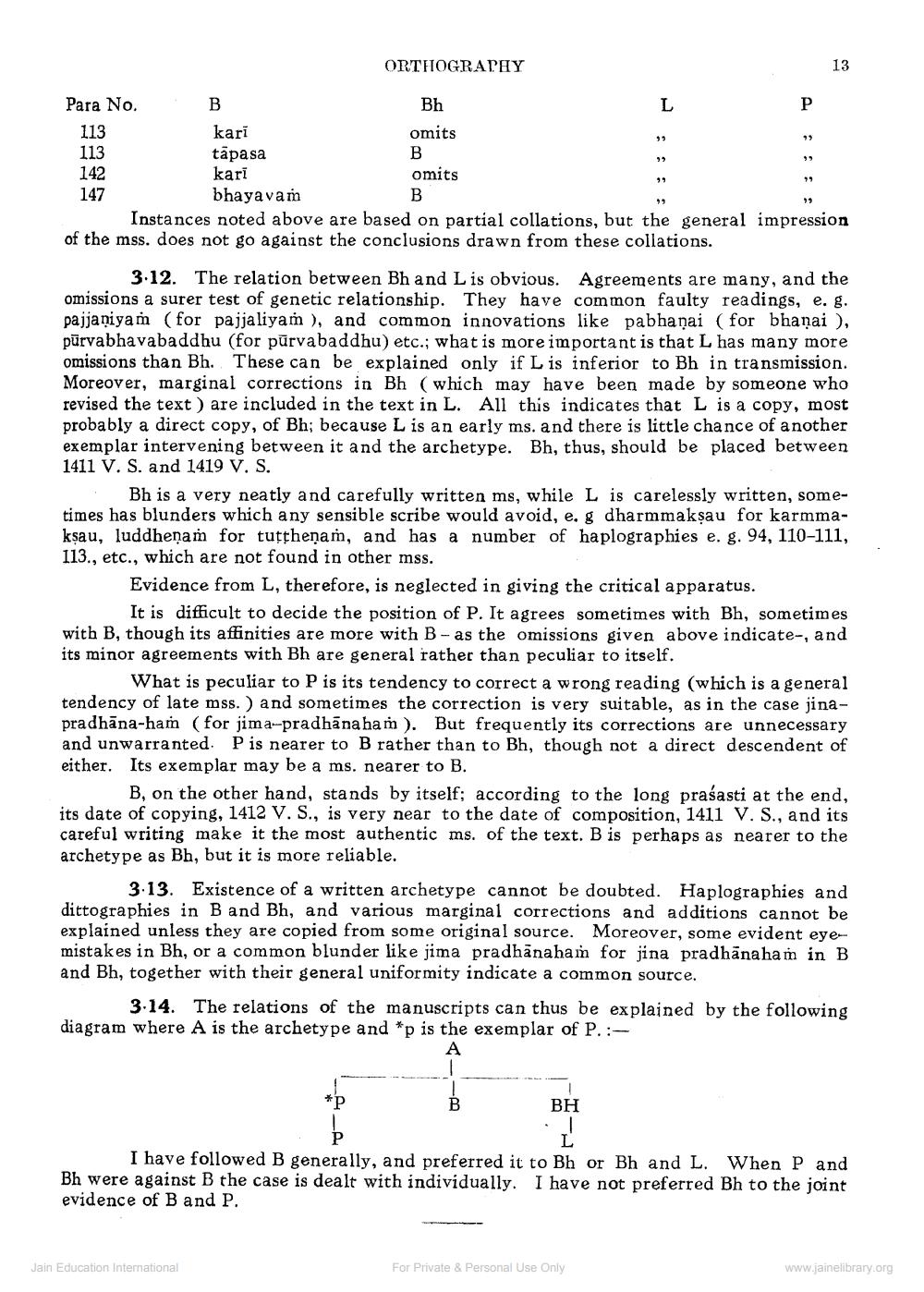________________
ORTHOGRAPHY
13
Para No. в
Bh 113 kari
omits tāpasa kari
omits 147
bhayavam Instances noted above are based on partial collations, but the general impression of the mss. does not go against the conclusions drawn from these collations.
113 142
3.12. The relation between Bh and L is obvious. Agreements are many, and the omissions a surer test of genetic relationship. They have common faulty readings, e. g. pajjaniyam (for pajja liyam ), and common innovations like pabhanai (for bhanai ), pūrvabhavabaddhu (for pūrvabaddhu) etc., what is more important is that L has many more omissions than Bh. These can be explained only if L is inferior to Bh in transmission. Moreover, marginal corrections in Bh (which may have been made by someone who revised the text ) are included in the text in L. All this indicates that L is a copy, most probably a direct copy, of Bh; because L is an early ms. and there is little chance of another exemplar intervening between it and the archetype. Bh, thus, should be placed between 1411 V. S. and 1419 V. S.
Bh is a very neatly and carefully written ms, while L is carelessly written, sometimes has blunders which any sensible scribe would avoid, e. g dharmmakşau for karmmaksau, luddhenam for tuţthenam, and has a number of haplographies e. g. 94, 110-111, 113., etc., which are not found in other mss.
Evidence from L, therefore, is neglected in giving the critical apparatus.
It is difficult to decide the position of P. It agrees sometimes with Bh, sometimes with B, though its affinities are more with B - as the omissions given above indicate-, and its minor agreements with Bh are general rather than peculiar to itself.
What is peculiar to P is its tendency to correct a wrong reading (which is a general tendency of late mss.) and sometimes the correction is very suitable, as in the case jinapradhāna-ham (for jima-pradhana ham). But frequently its corrections are unnecessary and unwarranted. P is nearer to B rather than to Bh, though not a direct descendent of either. Its exemplar may be a ms. nearer to B.
B, on the other hand, stands by itself; according to the long praśasti at the end, its date of copying, 1412 V. S., is very near to the date of composition, 1411 V. S., and its careful writing make it the most authentic ms. of the text. B is perhaps as nearer to the archetype as Bh, but it is more reliable.
3:13. Existence of a written archetype cannot be doubted. Haplographies and dittographies in B and Bh, and various marginal corrections and additions cannot be explained unless they are copied from some original source. Moreover, some evident eyemistakes in Bh, or a common blunder like jima pradhanaham for jina pradhānahan in B and Bh, together with their general uniformity indicate a common source.
314. The relations of the manuscripts can thus be explained by the following diagram where A is the archetype and *p is the exemplar of P.:
A
-
-
*p
BH
LP
I have followed B generally, and preferred it to Bh or Bh and L. When P and Bh were against B the case is dealt with individually. I have not preferred Bh to the joint evidence of Band P.
Jain Education International
For Private & Personal Use Only
www.jainelibrary.org




